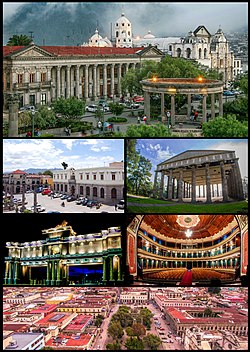Quetzaltenango
Xelajú (K'iche') | |
|---|---|
Municipality and city | |
 Historical buildings, Streets, Minerva Temple, Arch sixth state of Los Altos, Interior of Municipal Theater and Historical center. | |
| Coordinates: 14°50′40″N 91°30′05″W / 14.84444°N 91.50139°W | |
| Country | |
| Department | |
| Spanish Foundation | May 15, 1524 |
| Government | |
| • Type | Municipality |
| • Mayor | Juan Fernando López, Partido Humanista |
| Area | |
• Municipality and city | 122 km2 (47 sq mi) |
| Elevation | 2,330 m (7,640 ft) |
| Population (2018 census)[1] | |
• Municipality and city | 180,706 |
| • Density | 1,500/km2 (3,800/sq mi) |
| • Urban | 180,706 |
| Demonym | Quetzalteca/o |
| Time zone | UTC-6 (Central America) |
| Climate | Oceanic climate: subtropical highland variety (Cwb) |
Quetzaltenango (Spanish pronunciation: [ketsalteˈnaŋɡo], also known by its Maya name Xelajú [ʃelaˈχu] or Xela [ˈʃela]) is both the seat of the namesake Department and municipality, in Guatemala. The city is located in a mountain valley at an elevation of 2,330 meters (7,640 feet) above sea level at its lowest part. It may reach above 2,400 m (7,900 ft) within the city.
The Municipality of Quetzaltenango consists of an area of 122 km2 (47 sq mi). Municipalities abutting the municipality of Quetzaltenango include Salcajá, Cantel, Almolonga, Zunil, El Palmar, Concepción Chiquirichapa, San Mateo, La Esperanza, and Olintepeque in Quetzaltenango department and San Andrés Xecul in Totonicapán department.
- ^ Citypopulation.de Population of departments and municipalities in Guatemala
- ^ Citypopulation.de Population of the major cities in Guatemala
